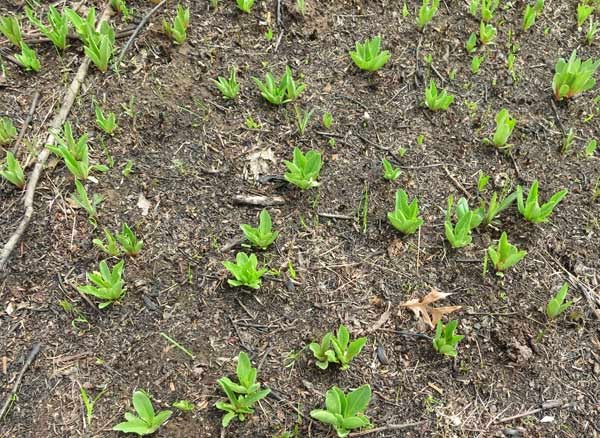Although native, quaking aspen (Populus tremuloides) is completely undesirable in any restored natural
area in the Midwest and should be eradicated. Girdling is the only effective
procedure and the next few weeks are the ideal time to carry this out.
The primary
growth of aspen is asexual by underground runners. The typical aspen
"grove" is a multi-stemmed clone in which all the roots are
interconnected. If an injury to a root occurs, there will be a rapid response
by the clone, and new shoots ("suckers") will be sent up all over the
area. New shoots have been known to arise as far as 50 feet from the nearest
aspen tree! The clone may expand simultaneously in several directions, as
influenced by environmental conditions.
If a single tree
or a whole aspen clone is cut, massive numbers of new shoots (called root suckers)
will be sent up. An area that had perhaps 5 or 10 large aspen trees will soon
have hundreds of small aspen stems. There is only one certain way of killing an aspen
clone and this is by girdling.
 Girdling
means stripping a layer of bark and the underlying cambium and phloem in a band
around the trunk. The phloem
vessels translocate sugars and other nutrients to the roots, so if the phloem
tubes are broken, the roots become starved of food. The xylem vessels, which
translocate water to the leaves, are not affected by girdling. With girdling,
the upper part of the tree still remains alive, since photosynthesis can
continue. Eventually, however, the roots die, and the whole tree dies. The
first year after girdling, the clone may appear almost normal, but by the
second year the clone usually dies. The dead trunks can then be cut without
stimulating resprouting.
Girdling
means stripping a layer of bark and the underlying cambium and phloem in a band
around the trunk. The phloem
vessels translocate sugars and other nutrients to the roots, so if the phloem
tubes are broken, the roots become starved of food. The xylem vessels, which
translocate water to the leaves, are not affected by girdling. With girdling,
the upper part of the tree still remains alive, since photosynthesis can
continue. Eventually, however, the roots die, and the whole tree dies. The
first year after girdling, the clone may appear almost normal, but by the
second year the clone usually dies. The dead trunks can then be cut without
stimulating resprouting.
In contrast to cutting, girdling does not induce the
formation of root suckers. (There is an interesting but complex plant hormonal process involved in
root sucker formation.)
Depending on the size of the tree, different tools can be
used in girdling an aspen, but we have found the most effective is a discarded
truck spring that is sharpened on one side, which helps in making the initial
cut. Once the bark is penetrated, it is peeled back all around the trunk, as
the photo shows. It is essential that a complete ring is made, otherwise the
tree may be able to repair the damage. Also, every tree in the clone must be
girdled.
After girdling, one must wait a year or so for the tree to
die. The dead trees can then be cut and stacked for later burning. (Aspen logs do
not make very good firewood.)
Although the process described above will eradicate the
aspen clone, not all the roots are killed, so that scattered root suckers may
appear in subsequent years. (We have had scattered aspen root suckers from a clone as long
as 25 years later.) Thus the site should be monitored, and new suckers killed.
The best way to kill these small suckers is with basal bark treatment with
Garlon 4 (15-20%) in oil. (My preferred way is to apply the herbicide by a
paint stick.)
The U.S. Forest Service has an excellent publication on aspen growth and ecology. Although dealing mainly with Western aspen, it does include information on Lake States populations. It is available as a PDF for download at the U.S.F.S. publications web site as General Technical Report RM-119. There is also a nice treatment of aspen in the volume on Silvics in North America. The aspen chapter can be downloaded at the following link:
http://www.na.fs.fed.us/pubs/silvics_manual/volume_2/populus/tremuloides.htm














